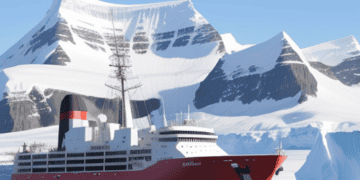A new collaborative initiative between Canada and Spain has led to the establishment of an Antarctic Ocean Observatory. Ocean Networks Canada (ONC), an entity affiliated with the University of Victoria, and the Spanish National Research Council (CSIC) have teamed up to operate a subsea observatory at the Spanish Antarctic Station. This marks the first instance of ONC extending its ocean monitoring operations beyond Canadian waters. The observatory is part of an effort to increase scientific understanding of the Southern Ocean, also known as the Antarctic Ocean, which remains one of the least observed regions on Earth. The Spanish research vessel Hespérides, which is transporting the ONC observatory, is currently on its way to the Spanish Antarctic Station, Juan Carlos I, located on Livingston Island in the South Shetlands Archipelago.
Alongside the observatory, the Hespérides is also carrying two ONC deep-sea Argo floats, set to be deployed in the Drake Passage during its journey. Departing from Barcelona and scheduled to leave Ushuaia, Argentina, the vessel aims to reach the Antarctic station later this month. Kate Moran, President and CEO of ONC, highlighted the significance of this partnership in polar scientific collaboration. She noted ONC’s experience in monitoring Arctic conditions since 2012 and its capabilities in operating underwater observatories in extreme polar environments. This expertise will complement Spain’s scientific efforts in monitoring Antarctica, a key region for understanding global climate systems.
Jordi Sorribas Cervantes, director of the Unit of Marine Technology at CSIC, emphasized the importance of this partnership for providing essential ocean data in the Southern Ocean. The year-round operation of the new observatory is particularly valuable for capturing continuous data during the Antarctic station’s unstaffed winter months. The observatory will be located at Johnsons Dock, at a depth of 23 meters. It will feature a CTD scientific instrument for measuring conductivity, temperature, and depth, along with additional sensors for dissolved oxygen and optical properties such as turbidity and chlorophyll-a. This setup will enable monitoring of seawater quality, especially where freshwater glacier melt and ocean water intersect.
David Hik, POLAR chief scientist and executive director, remarked on the partnership’s role in advancing ocean monitoring and Canada’s contributions to Antarctic research. The initiative aligns with the University of Victoria’s commitment to the United Nations Sustainable Development Goals and its focus on climate action, life below water, and sustainable communities. Lisa Kalynchuk, vice-president of research and innovation at UVic and an ONC board member, praised ONC’s international expansion in ocean science, which supports global climate solutions and showcases the university’s role in driving technological innovation and scientific discovery.
Get the best supply chain report news insights on The Supply Chain Report. Visit ADAMftd.com for free international trade tools.
#CanadaSpainAntarcticCollaboration #AntarcticOceanObservatory #OceanNetworksCanada #SpanishNationalResearchCouncil #SouthernOceanScience #HesperidesExpedition #ArcticAntarcticResearch #OceanDataMonitoring #ClimateScience #GlobalOceanObservatories #UVicResearch #MarineTechnologyCSIC #SustainableOcean

















